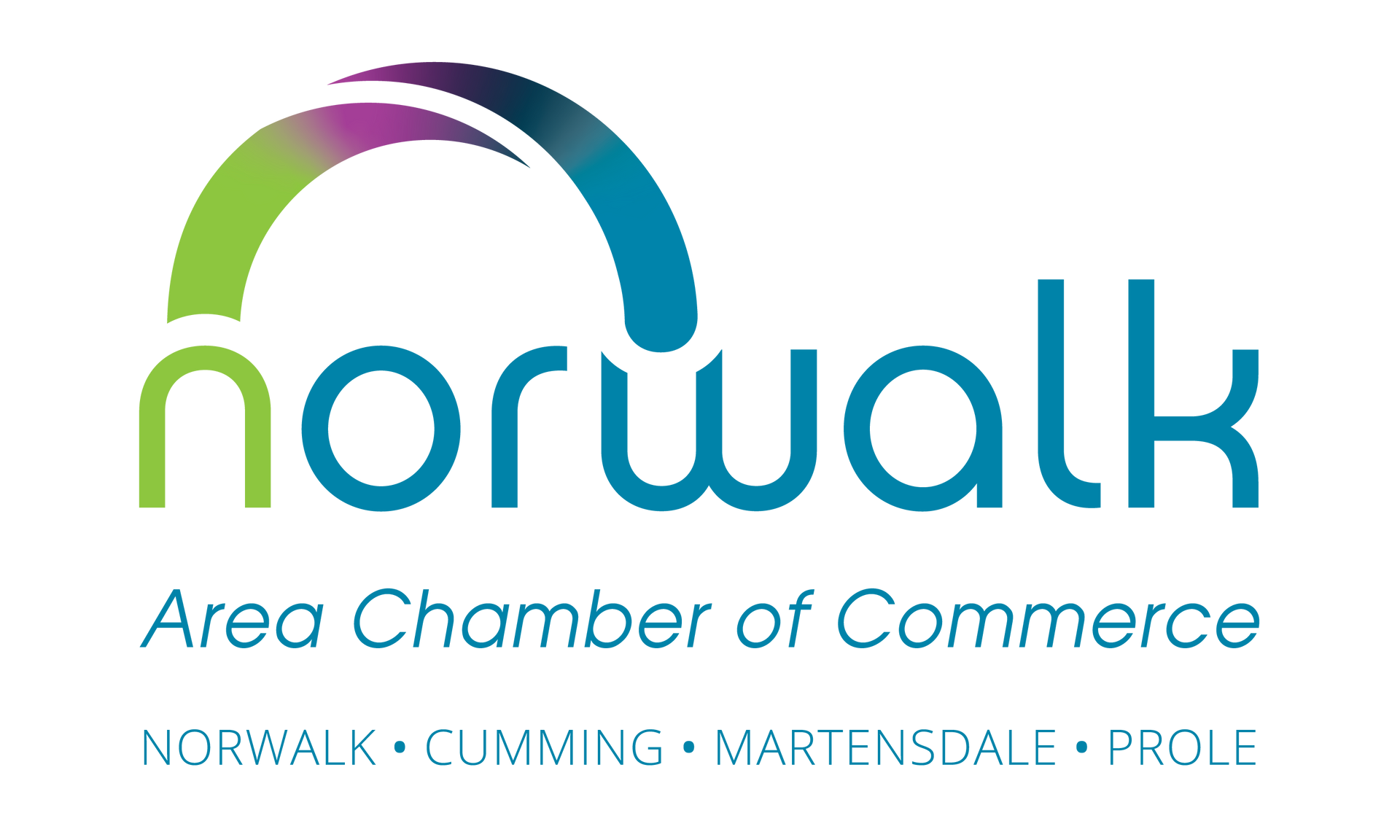HISTORY OF NORWALK
NORWALK, IA
NORWALK CITY HISTORY -
The first settlers came to the Norwalk area about 1846. One of them, Samuel Crow, settled near the North River. The first construction on the site that is now Norwalk began with a log cabin built by Samuel Snyder. The following year more families settled in the little town then known as Pyra.
A post office was established June 18, 1856. George W. Swan laid out the town and erected a hotel. Mr. Swan, who was born in Norwalk, Connecticut, and was associated with a newspaper in Norwalk, Ohio, changed the town’s name to Norwalk.
The first railroad into town was constructed in 1882, a narrow gauge line from Des Moines to Cainsville, Missouri. In the 1890s the railroad was acquired by a subsidiary of the Burlington Railroad and was widened to standard gauge. Its primary use was for shipping the farmers’ livestock to the carious markets. The line was abandoned in 1947, after a flood had severely damaged the North River Bridge.
INCORPORATED
Norwalk was incorporated in 1900 with Adam Stiffler serving as its first mayor. At that time, the town was one square mile in size. Since then many additions have been made. The first was the triangle formed by Highway 28, High Road and Cherry Parkway on November 11, 1969. The second was the section north of town, developed as a residential area. It includes the Norwalk United Methodist Church and the Regency Nursing Home. The next large annexation was part of the Howard Hughes farm March 9, 1972. On November 15, 1973, the Casady farm on Cumming Road was annexed. There has been no development on that property. The next annexation was the Max Willison farm on the east side of Norwalk. This tract, annexed on September 29, 1977, was developed as Windflower, a residential housing project. On December 19, 1977, the Ray Emery farm west of the city was annexed and on November 20, 1985, the Holland farm on the north side of Norwalk was annexed. This extended the city limits to the country store along the east side of Highway 28.
LAKEWOOD ANNEXATION
On April 1, 1989, the communities of Lakewood and Echo Valley were annexed. The Lakewood area development was started in 1965, by the Clark Development Company. Today there are over 500 homes, one church, parks and a 170-acre lake with a marina and swimming beach. In the early 1970s the Albright Development Company began construction on the residential housing area of Echo Valley, which has over 60 homes.
Major annexations in the last two years have brought an additional square mile into the community. Larry Hughes is proposing a golf course community on the east side of Norwalk, Orville Crowley has 160 acres out west, and Colonial Meadows, working within a Town Center concept, is starting construction in the spring of 1999. Frank Gillotti is working with two developments. The first is on the north shore of Lake Colchester, and the second is west of Norwalk.
Routing, and noise abatement, sight issues, economic development issues and storm water issues have high-lighted a configured interchange with Iowa 28 and relocated Iowa 5, the Des Moines beltway. The City has been working to insure that concerns raised are addressed in a project that should be completed by December 2000.
The 1998 population estimate is 6,850.
DID YOU KNOW?
In 1995 the site of Countryside Golf Course, a site of about 140 acres was annexed.
In 1999 the Ghrist property of some 360 acres was annexed in and today is the site of the town center-golf community known as the Legacy. The property adjoins the existing Holland ground to the west, which serves as an extension of the 18th hole Legacy Golf Club.
In 1903 phone service began in town.
The first settlers came to Norwalk area about 1846. One of them, Samuel Crow, settled near the North River. The first construction on the site that is now Norwalk began with a log cabin built by Samuel Snyder. The following year more families settled in the little town known as Pyra.
A post office was established June 18, 1856. George W. Swan laid out the town and erected a hotel. Mr. Swan, who was born in Norwalk, Conneticut, and was associated with a newspaper in Norwalk, Ohio, changed the town's name to Norwalk
The first railroad into town was constructed in 1882 a narrow gauge line from Des Moines to Cainsville, Missouri. In the 1890's the railroad was acquired by a subsidiary of the Burlington Railroad and was widened to standard gauge. Its primary use was for shipping the farmers' livestock to various markets. The line was abandoned in 1947, after a flood had serverly damaged the North River bridge.
Incorporated
Norwalk was incorporated in 1900 with Adam Stiffler serving as its first mayor. At the time, the town was one square mile in size. Phone service began in 1903. Since then many additions have been made. The first was the triangle formed by Highway 28, High Road and Cherry Parkway on November 11, 1969. The second was the section north of town, developed as a residential area. It includes the Norwalk United Methodist Church and the Regency Nursing Home. The next large annexation was part of the Howard Hughes farm March 9, 1972. On November 15, 1973, the Casady farm on Cumming Road was annexed. There has been no development on that property. The next annexation was the max Willison farm on the east side of Norwalk. This tract, annexed on September 29, 1977, was developed as Windflower, a residential housing project. On December 19, 1977, the Ray Emery farm west of the city was annexed and on November 20, 1985, the Holland farm on the north side of Norwalk was annexed. This extended the city limits to the country store along the east side of Highway 28.
Lakewood Annexation
On April 1, 1989, the neighborhoods of Lakewood and Echo Valley Estates were annexed into Norwalk. The original Lakewood development was started in 1965 around the man-made Lake Colchester. The south shore of the lake is home to nearly 600 residences and the north side is in the process of being planned for development in 2001 and beyond. The north shore, owned by the Gillotti family, could host an equal or greater number of residential units including commercial and office space.
Echo Valley began in the early 1970s, and while the existing area is filled up, the surrounding ground is proposed for commercial, office and residential uses by the owners, Coppolla Properties. A portion is already annexed in and more is to follow.
The City has worked with neighborhood groups to protect the residents of the north side of Norwalk with the relocations of Iowa 5, Iowa 28 and Runway 5-23 at the Des Moines International Airport. Many of these improvements are still on schedule to be completed by the end of 2001.
Other recent annexations of note include: the Larry Hughes property at the corner of North Avenue and R57; the Willard Freese property on the west North Avenue as well as ground owned by Orville Crowley. The Hughes site is the home of Countryside Golf Course which has nine bent grass holes completed, and nine under construction. Also new in 2002 will be a clubhouse.
The most recent annexation consisted of 320 acres owned by Colonial Meadows LLC. The company, formed by the Ghrist family, is a local development utilizing a town center concept versus the town square concept found in many older communities. The development will be the site of a variety of housing, commercial and office space needs for the south Metro/Norwalk area.
The “Legacy”, a new golf course community incorporating the existing Colonial Meadows development, will present Norwalk with 18 new PGA caliber golf holes, 400+ home sites, and a potential tantalizing array of commercial opportunities for Norwalk. The effort is a partnership of the Colonial Meadows group and Hubbell Realty.
Another major housing development, Rolling Green, is under way across from the Countryside Golf Course and will consist of some 250 plus homes. Sharon Heights has 35 potential lots as well.
Finally, the City has incorporated 35 acres of NBC ground into recreational fields for soccer, baseball and softball into a complete complex to serve the needs of the community. In addition the City is marketing the remaining ground as part of its business complex (the only development in Norwalk that the City has authorized tax abatement and tax increment financing for as a joint incentive). It truly is the “Norwalk Business Park.”
* Provided by Norwalk Chamber of Commerce.




